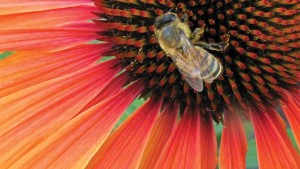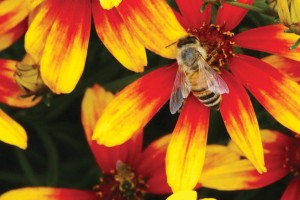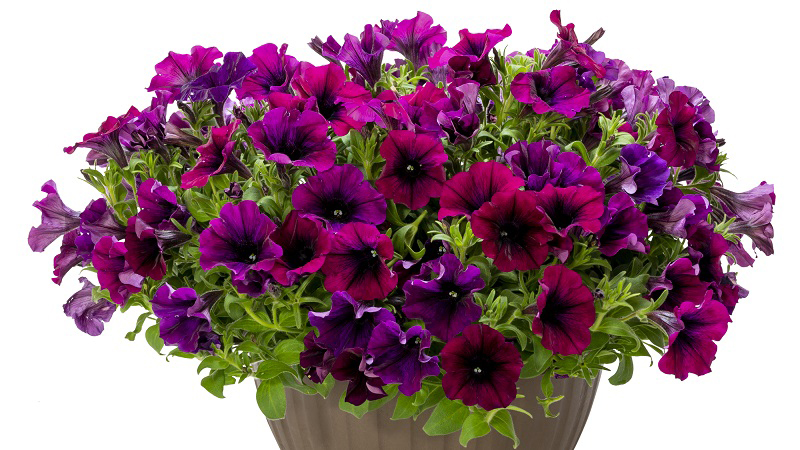Breeders Go The Distance To Bring New Plant Varieties To Market

Breeders are paying attention to the pollinator-attracting characteristics of the plants they develop.
Photo courtesy of Terra Nova Nurseries.
Breeders are continually bringing innovative products to a market with an insatiable need for new varieties. It’s a task that requires their best efforts, matched with strong-performing, market-specific genetics and the latest breeding technologies available.
With the constant market demand, breeders feel the pressure to introduce varieties in a timely manner, while still leaving enough time for refinements to the breeding process itself, so new varieties will have the best chance for commercial success. They are recognizing that engaging growers early in the trialing process is an important part of bringing strong-performing plants to the market.
Extended Trialing Through Grower Partnerships
When Ball Selecta, breeder of Petunia ‘Night Sky,’ knew it had a unique variety on its hands, it asked the grower community for help to refine the production process, opting for an openly positioned large sample year in 2016, to get grower input prior to a large launch in 2017.
“This process opened more detailed lines of two-way communication between our development team and the growers trialing ‘Night Sky,’ says Gary Vollmer, Product Manager and Technical Support at Selecta. “It is showing us that when we team up with growers to do the research in their own facilities, we all move further faster to achieve the goal of developing products with maximized performance and consumer appeal.”
Getting Results With Technology
Danziger “Dan” Flower Farm also makes earlier decisions on variety candidates, to test plants over longer periods in regional locations for garden performance and to give extra value to consumers.
“We are constantly expanding our knowledge and use of molecular genetics and biotechnology to bring notable benefits to all parts of the value chain,” says Chanochi Zaks, Vice President of Danziger. “We are also focusing our breeding efforts to become more accurate and aligned with market demand. Therefore, we use all the technological improvements available to get better and faster results.”
MemoGene, a virus-based tissue-culture-independent technology for precise plant genomic alteration without using traditional genetic engineering, is one advanced breeding technique Danziger uses to get results.
With the addition of its new tissue culture lab in Santa Paula, CA, Green Fuse Botanicals is using advanced breeding technologies to improve the consistency of its supply chain. The new lab will facilitate the development of items that can’t be supplied from offshore, such as the large-flowered Staircase Lupine series, a new product that debuted at California Spring Trials 2016.
Breeding That Crosses Borders
Other breeders are using international connections to bring innovative introductions to the market.
One of the more interesting is the Convention on Biological Diversity (CBD), which plays a significant role in Sakata’s new genetics. CBD is a multilateral treaty, with more than 200 participating countries, that develops national strategies for the conservation and sustainable use of biological diversity.
Sakata partners with CBD countries to commercialize their native species, and then shares royalties generated from those products to help with conservation efforts in the country of origin. Mercardonia ‘Magic Carpet Yellow,’ native to Argentina, is a Sakata introduction that came about through the CBD.
Kientzler displayed some of its European combinations, now available to the U.S., at 2016 California Spring Trials. Steve Rhinehart, Program Manager for Kientzler North America, says the company’s breeding team is tightly connected to production in Europe, where breeders like to focus on grower improvements, as well as enhanced garden consumer traits. Nemesia ‘Babycakes’ is one example of these collaborations.
Breeding In Value
Whatever method breeders turn to, the end game is the same, to strengthen the market with new varieties that have lasting value for both the grower and the end consumer. As breeders keep that goal in mind, the industry can expect to see continued advancements in breeding technology and trialing methods that make it much easier for growers to produce plants that sell.

Pollinators have become as much of the end consumer for breeders as people have. Photo courtesy of Terra Nova Nurseries.
Breeding For The End Consumer
Terra Nova Nurseries, Proven Winners, Beekenkamp, and Hort Couture — they’re among the many breeders refining plant characteristics with the end consumer in mind. Terra Nova concentrates on breeding that won’t disappoint the end consumer, with perennials that maintain their original height from year one and onward. The company’s breeding work has a positive ecological direction, concentrating on lower chemical use and plants with pollinator attractiveness traits.
“I used to say the end consumer was the person who purchased our plants at retail, but it looks like our end consumers are actually the pollinator insects,” says Chuck Pavlich, Director of New Product Development at Terra Nova Nurseries.
Proven Winners aims its attention at breeding varieties with dual attributes, such as attracting pollinators into the garden and extended-season performance. Director of New Products Kevin Hurd says the company is excited about the wide range of interspecific hybrids available that give it a chance to improve the flowering time of varieties, and to offer plants to consumers that need less water and offer even greater garden performance with less care needed.
At Beekenkamp, consumer satisfaction is always the end goal, says Sales Manager Martijn Kuiper. If a variety is technically good, but does not perform on a consumer level, it is not introduced to the market.
Hort Couture is addressing consumer needs for small-space varietes and vegetable and herbs. It looks for compact varieties that play well with each other in container combinations. And this year it plans a revamp of its Culinary Couture Collection for a Health, Happiness, and Hort Couture campaign.









